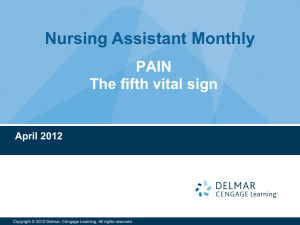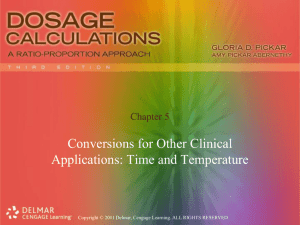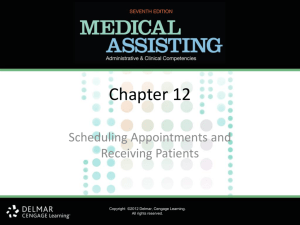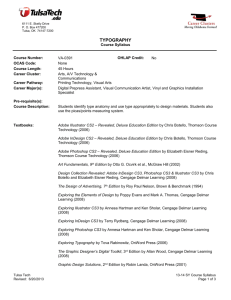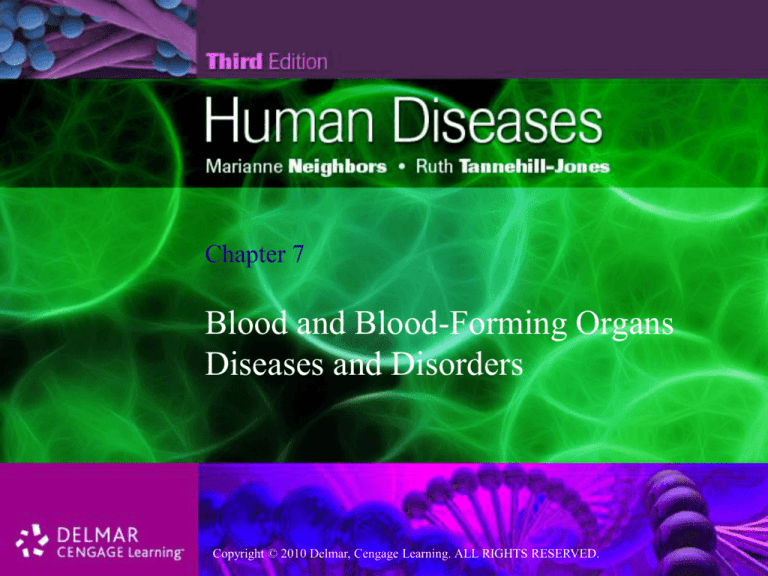
Chapter 7
Blood and Blood-Forming Organs
Diseases and Disorders
Copyright
Copyright
© 2010
© 2010
Delmar,
Delmar,
Cengage
Cengage
Learning.
Learning.
ALLALL
RIGHTS
RIGHTS
RESERVED.
RESERVED.
Anatomy and Physiology
• Hematologic system
• Major functions of blood:
– Transport nutrients to cells
– Aid removal of wastes
• Average adult has 5 to 6 liters of circulating
blood
Copyright © 2010 Delmar, Cengage Learning. ALL RIGHTS RESERVED.
Blood Components
Copyright © 2010 Delmar, Cengage Learning. ALL RIGHTS RESERVED.
Anatomy and Physiology
• Erythrocytes
– Normal count:
• 4.2 to 6.3 million
– Life span:
• 120 days
– Form in bone marrow and do not reproduce
Copyright © 2010 Delmar, Cengage Learning. ALL RIGHTS RESERVED.
Anatomy and Physiology
• Hemoglobin important in oxygen transport
• Normal hemoglobin:
– Male
• 13.5 to 18 hemoglobin in grams (gm)/100 milliliter (ml)
– Female
• 12 to 16 gm/100ml
Copyright © 2010 Delmar, Cengage Learning. ALL RIGHTS RESERVED.
Anatomy and Physiology
• Leukocytes protect individual from infection
– Normal count:
• 4,500 to 11,000
Copyright © 2010 Delmar, Cengage Learning. ALL RIGHTS RESERVED.
Anatomy and Physiology
• Platelets
– Also known as thrombocytes
– Important in blood clotting
– Normal count:
• 150,000 to 350,000
Copyright © 2010 Delmar, Cengage Learning. ALL RIGHTS RESERVED.
Anatomy and Physiology
• Blood-forming organs:
–
–
–
–
Lymph nodes
Bone marrow
Spleen
Liver
• Lymph system protects against pathogens
Copyright © 2010 Delmar, Cengage Learning. ALL RIGHTS RESERVED.
Anatomy and Physiology
• Bone marrow
– Major blood cell producer
• Spleen produces lymphocytes, plasma cells,
and antibodies to filter microorganisms from
blood
• Liver produces prothrombin and fibrinogen for
blood clotting
Copyright © 2010 Delmar, Cengage Learning. ALL RIGHTS RESERVED.
Animation
Click Here to Play Blood Animation
Copyright © 2010 Delmar, Cengage Learning. ALL RIGHTS RESERVED.
Common Signs and Symptoms
• Erythrocytopenia
– Decrease in RBCs leading to anemia
– Symptoms:
•
•
•
•
•
Fatigue
Headache
Low RBCs
Pallor
Shortness of breath
Copyright © 2010 Delmar, Cengage Learning. ALL RIGHTS RESERVED.
Common Signs and Symptoms
• Erythrocytosis
– Increased RBCs
– Symptoms:
•
•
•
•
•
High RBCs
Reddened skin tones
Bloodshot eyes
Increased blood volume and pressure
Increased blood volume of heart
Copyright © 2010 Delmar, Cengage Learning. ALL RIGHTS RESERVED.
Common Signs and Symptoms
• Leukocytopenia
– Decreased white blood cells
– Weakens immune system
• Leukocytosis
– Increased white blood cells
– Normal response to acute infections
Copyright © 2010 Delmar, Cengage Learning. ALL RIGHTS RESERVED.
Common Signs and Symptoms
• Thrombocytopenia
– Decreased platelet count leading to coagulation problem
– Symptoms:
• Petechiae
– Small hemorrhages in skin
• Ecchymoses
– Large areas of bruising or hemorrhage
Copyright © 2010 Delmar, Cengage Learning. ALL RIGHTS RESERVED.
Common Signs and Symptoms
• Thrombocytopenia
– Symptoms:
• Epistaxis
– Nosebleeds
• Bleeding in mouth, gums, and mucous membranes
Copyright © 2010 Delmar, Cengage Learning. ALL RIGHTS RESERVED.
Common Signs and Symptoms
• Thrombocytosis
– Increase in platelets
– Uncommon
– Usually no serious side effects
Copyright © 2010 Delmar, Cengage Learning. ALL RIGHTS RESERVED.
Diagnostic Tests
• Complete blood count with differential and
indices
• Biopsy of blood-forming organs
• Hematocrit (Hct) reflects amount of red cell
mass as proportion of whole blood
• Hemoglobin (Hgb) reflects blood’s oxygencarrying potential
Copyright © 2010 Delmar, Cengage Learning. ALL RIGHTS RESERVED.
Diagnostic Tests
• Bleeding time determines platelet disorders
– E.g., hemophilia, thrombocytopenia, disseminated
intravascular coagulation
• Prothrombin time (PT) and partial prothrombin
time (PTT) measure blood’s ability to clot
Copyright © 2010 Delmar, Cengage Learning. ALL RIGHTS RESERVED.
Diagnostic Tests
• Biopsy
– Bone marrow
– Lymph node
Copyright © 2010 Delmar, Cengage Learning. ALL RIGHTS RESERVED.
Disorders of Red Blood Cells
• Anemia
– Decrease in oxygen-carrying ability of RBC
– Symptoms:
• Pallor
• Fatigue
• Shortness of breath
Copyright © 2010 Delmar, Cengage Learning. ALL RIGHTS RESERVED.
Disorders of Red Blood Cells
• Anemia
– Symptoms:
•
•
•
•
Tachycardia
Headache
Irritability
Syncope
Copyright © 2010 Delmar, Cengage Learning. ALL RIGHTS RESERVED.
Disorders of Red Blood Cells
• Iron deficiency anemia
– Loss of iron or inadequate intake of iron
– Causes:
• Blood loss
• Low dietary intake
– Treatment:
• Increase dietary intake of iron
Copyright © 2010 Delmar, Cengage Learning. ALL RIGHTS RESERVED.
Disorders of Red Blood Cells
• Folic acid deficiency anemia
– Folic acid needed for maturation of RBCs
– Causes:
• Poor diet
• Overcooking of vegetables
• Over consumption of alcohol
– Treatment:
• Increase folic acid intake by eating green and yellow vegetables
Copyright © 2010 Delmar, Cengage Learning. ALL RIGHTS RESERVED.
Disorders of Red Blood Cells
• Pernicious anemia
– Lack of intrinsic factor leading to inadequate absorption of
vitamin B12
– Treatment:
• Monthly injections of vitamin B12 for life
Copyright © 2010 Delmar, Cengage Learning. ALL RIGHTS RESERVED.
Disorders of Red Blood Cells
• Hemolytic anemia
– Destruction of RBCs related to antibody-antigen reaction
– Disorder of immune system leading to destruction of
erythrocytes
– Treatment:
• Exchange transfusion and/or splenectomy
Copyright © 2010 Delmar, Cengage Learning. ALL RIGHTS RESERVED.
Disorders of Red Blood Cells
• Sickle cell anemia
– Hereditary
– Found in African American race
– Abnormal sickle shape of erythrocyte
• Does not allow cell to travel smoothly through vessels
– Symptomatic treatment
– No cure
Copyright © 2010 Delmar, Cengage Learning. ALL RIGHTS RESERVED.
Disorders of Red Blood Cells
• Aplastic anemia
– Failure of bone marrow to produce blood components
– Causes:
•
•
•
•
Chemotherapy
Radiation
Viruses
Toxins
Copyright © 2010 Delmar, Cengage Learning. ALL RIGHTS RESERVED.
Disorders of Red Blood Cells
• Aplastic anemia
– Treatment:
• Avoid causative agent
• Bone marrow transplantation
• Transfusions
Copyright © 2010 Delmar, Cengage Learning. ALL RIGHTS RESERVED.
Disorders of Red Blood Cells
• Polycythemia
– Too many blood cells
– Symptoms:
•
•
•
•
Enlarged spleen
Reddened mucous membranes
Bloodshot eyes
Deep red color on palms
Copyright © 2010 Delmar, Cengage Learning. ALL RIGHTS RESERVED.
Disorders of Red Blood Cells
• Polycythemia
– Treatment:
• Donate blood at regular intervals to reduce blood volume
Copyright © 2010 Delmar, Cengage Learning. ALL RIGHTS RESERVED.
Disorders of White Blood Cells
• Mononucleosis
– Also known as kissing disease
– Symptoms:
• Fatigue
• Sore throat
• Swollen glands
Copyright © 2010 Delmar, Cengage Learning. ALL RIGHTS RESERVED.
Disorders of White Blood Cells
• Mononucleosis
– Diagnosis by increased monocytes in white blood cells
(WBCs)
– Treatment:
• Rest
• Analgesics
• Throat gargles
Copyright © 2010 Delmar, Cengage Learning. ALL RIGHTS RESERVED.
Disorders of White Blood Cells
• Leukemia
–
–
–
–
Malignant neoplasm of blood-forming organs
Abnormal production of immature leukocytes
May be acute or chronic
Acute forms affect children, progress rapidly, and may be
fatal
Copyright © 2010 Delmar, Cengage Learning. ALL RIGHTS RESERVED.
Disorders of White Blood Cells
• Leukemia
– Chronic forms affect older adults, are often asymptomatic,
and may not be fatal
– Classified as:
• Myelogenous
– Affecting bone marrow
• Lymphocytic
– Affecting lymph nodes
Copyright © 2010 Delmar, Cengage Learning. ALL RIGHTS RESERVED.
Disorders of White Blood Cells
• Leukemia
– Diagnosis by bone marrow biopsy
– Symptoms:
• Fatigue
• Headache
• Sore throat
Copyright © 2010 Delmar, Cengage Learning. ALL RIGHTS RESERVED.
Disorders of White Blood Cells
• Leukemia
– Symptoms:
• Dyspnea bleeding of mucous membranes of mouth and
gastrointestinal (GI) system
• Bone and joint pain
• Enlargement of lymph nodes, liver, and spleen
– Infections common
Copyright © 2010 Delmar, Cengage Learning. ALL RIGHTS RESERVED.
Disorders of White Blood Cells
• Leukemia
– Treatment:
• Aggressive chemotherapy
• Once in remission, bone marrow transplant to replace neoplastic
tissue with normal tissue
• Remission at 50 percent
Copyright © 2010 Delmar, Cengage Learning. ALL RIGHTS RESERVED.
Disorders of White Blood Cells
• Hodgkin’s disease
– Most common lymphoma
– Symptoms:
• Painless enlargement of lymph nodes in neck
• Weight loss
• Fever
– Primarily affects young adults
• Average age of 35
Copyright © 2010 Delmar, Cengage Learning. ALL RIGHTS RESERVED.
Disorders of White Blood Cells
• Hodgkin’s disease
– Cause thought to be viral
– Diagnosis by presence of Reed-Sternberg cell in lymphatic
tissue
– Treatment:
• Radiation
• Chemotherapy
– If in remission for five years or more, complete cure possible
Copyright © 2010 Delmar, Cengage Learning. ALL RIGHTS RESERVED.
Disorders of White Blood Cells
• Non-Hodgkin’s lymphoma (NHL)
– Lymphomas lacking Reed-Sternberg cell
– Symptoms:
• Painless enlargement of lymph nodes of neck, axilla, and inguinal
areas
• Fever
• Night sweats
• Weight loss
Copyright © 2010 Delmar, Cengage Learning. ALL RIGHTS RESERVED.
Disorders of White Blood Cells
• Multiple myeloma
– Malignant neoplasm of plasma cells or B-lymphocytes
– Increases with age
• Peaks in 70s
– Plasma cells multiply abnormally in bone marrow
• Causes weakness
• Leads to fractures and bone pain
Copyright © 2010 Delmar, Cengage Learning. ALL RIGHTS RESERVED.
Multiple Myeloma
Copyright © 2010 Delmar, Cengage Learning. ALL RIGHTS RESERVED.
Disorders of White Blood Cells
• Multiple myeloma
– Diagnosis by honeycombed bone pattern, hypercalcemia,
Bence-Jones protein found in blood and urine, and bone
marrow biopsy
– Treatment:
• Chemotherapy
• Radiation
• Not effective
– Poor prognosis
Copyright © 2010 Delmar, Cengage Learning. ALL RIGHTS RESERVED.
Disorders of Platelets
• Hemophilia
– X-linked hereditary bleeding disorder
– Several types
• Type A
– Most common
– Male children from asymptomatic mothers
– Lack protein necessary for clot formation
Copyright © 2010 Delmar, Cengage Learning. ALL RIGHTS RESERVED.
Disorders of Platelets
• Hemophilia
– Symptoms:
• Epistaxis
• Bruising
• Prolonged bleeding
– Diagnosis by blood test
Copyright © 2010 Delmar, Cengage Learning. ALL RIGHTS RESERVED.
Disorders of Platelets
• Hemophilia
– Treatment:
•
•
•
•
Prevention of injury
Treat symptoms
Blood transfusions
Concentrated form of clotting protein
– No cure
Copyright © 2010 Delmar, Cengage Learning. ALL RIGHTS RESERVED.
Disorders of Platelets
• Thrombocytopenia
– Also known as thrombocytopenia purpura
– Decrease in platelets leading to inability to normally clot
blood
– Symptoms:
• Abnormal bleeding in skin, mucous membranes, and internal
organs
• Petechiae
Copyright © 2010 Delmar, Cengage Learning. ALL RIGHTS RESERVED.
Disorders of Platelets
• Thrombocytopenia
– Symptoms:
•
•
•
•
Ecchymoses
GI hemorrhages
Epistaxis
Hematuria
Copyright © 2010 Delmar, Cengage Learning. ALL RIGHTS RESERVED.
Disorders of Platelets
• Thrombocytopenia
– Diagnosis by platelet count and bleeding time
– Treatment:
•
•
•
•
Avoid tissue trauma to reduce bleeding
Vitamin K
Transfusions of platelets
Splenectomy
Copyright © 2010 Delmar, Cengage Learning. ALL RIGHTS RESERVED.
Disorders of Platelets
• Disseminated intravascular coagulation (DIC)
– Abnormal clotting followed by abnormal bleeding
– Usually follows major trauma
• E.g., complicated childbirth, surgery, tissue destruction, septicemia,
snakebite, shock
– Multiple clots in capillaries
– Life-threatening
Copyright © 2010 Delmar, Cengage Learning. ALL RIGHTS RESERVED.
Disorders of Platelets
• DIC
– Symptoms:
•
•
•
•
•
Petechiae
Ecchymosis
Hematoma
Hematuria
GI bleeding
Copyright © 2010 Delmar, Cengage Learning. ALL RIGHTS RESERVED.
Disorders of Platelets
• DIC
– Symptoms:
• Hematemesis
• Blood in stool
– Treatment:
• Heparin
• Platelets
Copyright © 2010 Delmar, Cengage Learning. ALL RIGHTS RESERVED.
Disorders of Platelets
• Rare diseases
– Thalassemia
• Primarily affects people of Mediterranean descent
• Fragile, thin RBCs form defective hemoglobin
Copyright © 2010 Delmar, Cengage Learning. ALL RIGHTS RESERVED.
Disorders of Platelets
• Rare diseases
– von Willebrand’s disease
•
•
•
•
•
Hereditary
Congenital
Deficiency in clotting factor and platelet function
Also known as angiohemophilia
Affects females and males
Copyright © 2010 Delmar, Cengage Learning. ALL RIGHTS RESERVED.
Effects of Aging
• Age-related changes in other systems (e.g.,
immune, digestive) leave older adults more
susceptible to infections and nutritionally
related blood disorders
• Decreased iron
• Poor nutrition
Copyright © 2010 Delmar, Cengage Learning. ALL RIGHTS RESERVED.

